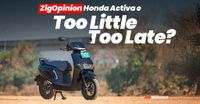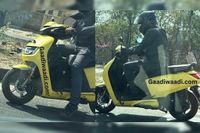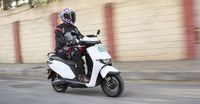In a significant move for the Indian electric vehicle market, Honda has officially launched its electric two-wheelers, the Activa e and the QC1, on March 26, 2025. This entry marks Honda's commitment to adapting to the growing demand for electric mobility in India, a country where the traditional scooter market has long been dominated by the Activa brand.
The Honda Activa e, which carries the legacy of its gasoline-powered predecessors, aims to blend practicality with modern electric technology. However, it faces challenges that may affect its acceptance among traditional Activa users. One of the most notable features of the Activa e is its swappable battery system, which allows users to change the battery in under a minute. A reviewer managed to swap the battery in just 36 seconds, showcasing Honda's efficiency in this area. However, the design compromises underseat storage space due to the necessity of accommodating two battery packs, forcing users to rely on limited floorboard space and small cubbyholes for their belongings.
On the other hand, the Honda QC1 is positioned as a more straightforward entry-level option for those looking to transition to electric mobility. The QC1 features a simple and minimalistic design, with body panels that reflect a city-oriented aesthetic. It is equipped with LED illumination, two ride modes—Econ and Standard—a USB-C charger, and a 5-inch LCD display. However, the display lacks a Distance to Empty (DTE) reading, which might frustrate users trying to gauge their travel distance accurately.
Powering the QC1 is a 1.8kW motor linked to a 1.5kWh battery, providing a top speed of 50 km/h and a maximum range of 80 km. Interestingly, the top speed drops to 30 km/h when in Econ mode, which aims to conserve battery life. A reviewer noted that they reached a top speed of 52 km/h, but many users may find this insufficient compared to the faster vehicles commonly found on urban roads.
While the QC1 offers a comfortable ride and a familiar feel akin to the petrol-powered Activa, the performance in Econ mode leaves much to be desired. The reviewer suggested that riding in Standard mode is preferable for most users to keep pace with traffic. Despite its basic features, the QC1 has been criticized for not being fast enough to meet the demands of modern urban commuting.
Both models face scrutiny regarding their pricing and usability. The Activa e is priced at a premium, ranging from Rs 1,17,000 to Rs 1,51,600 (ex-showroom, Bangalore), and its subscription model for the battery swapping system adds to the overall cost. The Basic plan is priced at Rs 1,999 per month for 35 kWh, suitable for 40 km per day. The more extensive Advance plan costs Rs 3,599 per month for 87 kWh, accommodating 100 km daily. This could lead to annual expenses nearing Rs 50,000, which is substantial compared to the initial scooter price.
The subscription model raises concerns among potential buyers who may not use the scooter frequently. Many users typically cover only 20-30 km daily, making the fixed monthly fee for battery swapping potentially burdensome. Critics argue that Honda should consider a more flexible pricing strategy based on actual usage, rather than a flat-rate subscription.
Moreover, the limited availability of the Activa e and QC1, currently offered only in major cities like Bangalore, Mumbai, and Delhi, restricts their market reach. This cautious approach might stem from Honda's significant investment in developing the battery swapping infrastructure, which is essential for the success of their electric models.
In the context of Honda's long-standing reputation in the scooter market, the transition to electric vehicles raises questions about whether these new models can uphold the brand's legacy. The Activa has consistently been one of the highest-selling scooters in India, known for its practicality and simplicity. However, as electric mobility gains traction, the adaptations required to meet modern demands could challenge the very essence of what made the Activa a household name.
As the electric vehicle landscape evolves, Honda's strategy of launching two distinct models—one with swappable batteries and another with a fixed battery—could be seen as convoluted. Industry experts suggest that a single model with a fixed battery and enhanced performance might have positioned Honda more competitively in the market.
In conclusion, while the launch of the Activa e and QC1 represents a bold step for Honda into the electric two-wheeler segment, their success will depend on how well they address the practical needs of consumers. The balancing act between innovation and tradition will be critical as Honda navigates this new terrain in the Indian automotive market.






